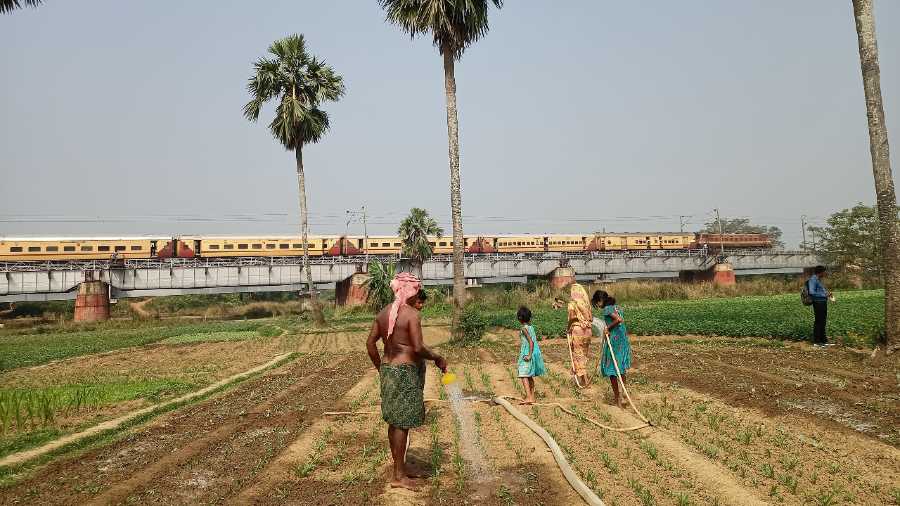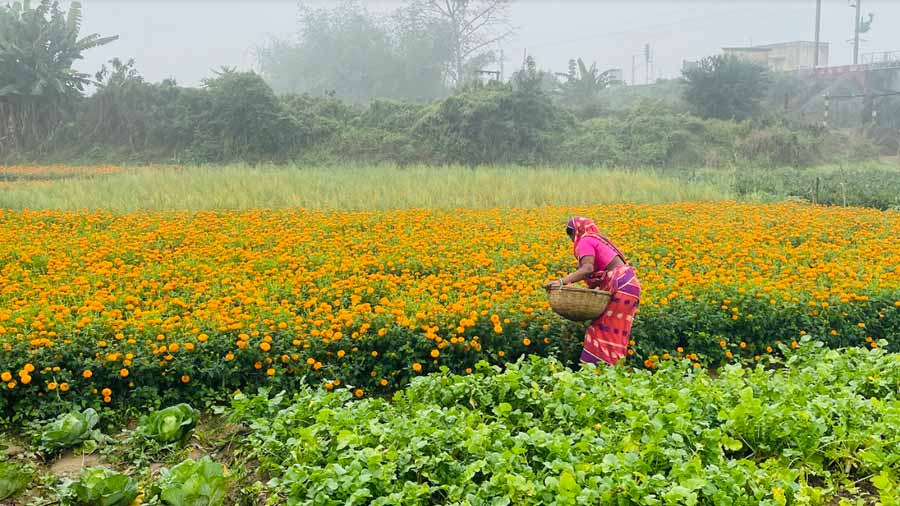In the midst of winter, I found there was, within me, an invincible summer.
— Albert Camus
There is a small river that rises on the fringes of the Chhota Nagpur plateau in Bengal and flows through the districts of Purulia, Bankura, East and West Midnapore before losing itself to the ocean. Kangsabati or Kasai is not a perennial river; its bed has dried up in many places. Instead, there are stretches of alluvial soil.
And therein lies our summer story.
Flower cultivation is the mainstay of most villages in and around East Midnapore’s Panskura block — Dokanda, Haur, Paschim Kolla, Jakpur, Madpur, Radhamohanpur...
Many may not know but Bengal happens to be among the major flower-producing states of India. And the districts leading the field are East Midnapore and Nadia.
“The Khirai region has since ages produced the bulk of this,” says Purnendu Kumar Maji, district magistrate of East Midnapore. “It covers about 2,500 acres and involves between 800 and 1,000 families. This huge produce goes to the Mallickghat flower market in Howrah and from there to other places.”
The fields are spread over two kilometres along the river, much of it on the riverbed itself. A railway bridge cuts through the expanse somewhere in the middle, and when a train is hooting across at full speed, the picture turns perfect.

The railway bridge beyond the farms. Paromita Kar
Khirai, actually the name of a railway station, has become synonymous with the entire region. Every winter Khirai is blooming. “Eto phul, shudhu phul... flowers upon flowers, only flowers,” says Balaram Bagh, 57, who has been a farmer here for the last 30 years.
But 2021 witnessed unprecedented and untimely rainfall. The lowlands of the Kangsabati lay submerged for several weeks in October-November. “The water level equalled twice the height of an adult man,” says Nirmala Jana. “Terrible floods,” says her husband, “We haven’t seen anything like this in many years.” Everything that was growing was annihilated.
The Janas grow “coron phul” or cornflowers. A garland of 20 pieces sells for Rs 200-250, says Nirmala. In bad times, for Rs 50-60. Apparently, the plant that bears ethereal flowers in blue, pink and white originally grew as a noxious weed in the cornfields of Europe, hence the name. But that is another story.
Sudip Jana is a YouTuber living in nearby Bakhrabad. His Facebook page, he says, played a part in making the place popular. Sometime in 2018, Sudip clicked a whole lot of photographs when he visited the fields with his friends, and uploaded them. When his posts went viral, others followed and the story is still growing.
“Winter is like a long flower festival,” says Sudip, “Food stalls and much footfall.” Of course, that also means damage to the fields and plants with unruly groups plucking flowers indiscriminately. “Parents don’t reprimand their children... after all, the blooms are the livelihood of the farmers.” The garbage that accumulates from all the partying is another issue. “I thought there would be a stampede at Khirai station,” says someone who visited the place on Saraswati Puja.
Sabita Gharai spends most of her day at her patch of morog jhuti or cock’s comb, the heads of which have turned a fierce crimson. The colour seems to have rubbed off on her demeanour as well. “Just because we do such laborious work doesn’t mean our children will go the same way,” she says, taking up the kodal or spade and landing sharp blows on a dry plot. The land isn’t hers — she is a sharecropper. Sabita’s son has just completed his diploma in engineering and her daughter gives private tuitions.
There’s something reassuring about rows and rows of green things just being there, drawing sustenance from the soil, swinging in the breeze and giving out stunning inflorescence. Carpets of marigolds, asters, roses, chrysanthemums, snapdragons, gladioli, dahlias and daisies spread as far as the eye can see. Khirai is increasingly referred to as Bengal’s very own valley of flowers.
Come to the north of Khirai railway bridge and it’s a land of roses and chrysanthemums mostly. Bagh, who lives in Paschim Kolla village, is known for his chandramallika fields. “I was the first one to grow this variety here,” he says. Son of a vegetable farmer, Bagh realised young that vegetables were far more labour intensive than flowers. The latter could also be much more profitable.
Bagh’s oeuvre took a significant turn seven years ago. Earlier, he used to grow snowballs. Those days he’d take the first train at 3.05am from Panskura to Howrah and sell his produce at the Mallickghat flower market. There, in that huge laboratory-cum-marketplace, he discovered new varieties and techniques. A particular type of chandramallika caught his eye — this one though smaller had more longevity and a stronger stalk. He began to grow saplings of this variety from stem cuttings.
“Today, about 90 per cent of my fields are for chandramallikas,” says Bagh, showing off his freshly-planted plots. Some of them have rows of light bulbs hanging on top, supported by bamboo scaffolding. The practice started six years ago. “This way the plants continue to make food at night too; their growth rate is faster.” However, the lights must be taken down two months before flowering. Constant light makes the plant body grow faster, but flowers are a different chapter. Again, the main as well as lateral buds that grow on stalks must be pinched at specific intervals to get the desired quality and quantity of blooms. “Human babies cry or speak out to let their needs be known; in the case of plants, farmers must know without being told,” he says.
Not all of Bagh’s fields are on the riverbed; some are on higher ground and were, therefore, spared the October annihilation. His flowers travel to the markets of Mumbai, Bangalore and Hyderabad too. “When demand is high, one flower fetches Rs 15,” he says.
The months of January and February have been full and blooming, despite everything. Says Bagh, “After all, this is poli mati... alluvial soil. It yields gold like only a few places can.”












